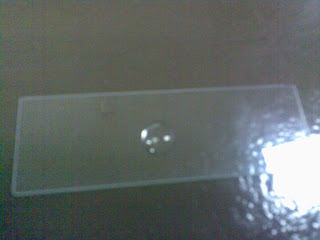- Remove a larvae from the vial provided and place it onto a drop of 0.7% saline solution
- Using a sharp forcep, a sharp needle, dissect the larvae and look for the salivary glands as shown in the pictures below.
- Tease out all other tissues and take only the salivary glands.
- Drain the saline off the slides and replace with HCL( Fixation of chromosomes; preserve the integrity of the structure) for a minute.
- Drain the HCL and replace with aceto-orcein stain(stain the cells). Let it stand for 10 minutes.
- Drain the stain and replace with acetic acid(fill the stain permanently). Let it stand for 1-3 minutes.
- Drain and replace with saline.
- Place a coverslip over the glands, using the thumb and a paper towel, push down on the slide. The pressure applied will squash the glands, rupture the nuclear membrane and free the chromosomes.
- Using a compound microscope, observe the slide at the different magnifications to check for the stained chromosomes.
- Make the slide permanent by brushing along the edges of the coverslip with nail polish.
More on Polytene Chromosomes
How are they formed?
Polytene chromosomes are formed when some specialized cells undergo repeated rounds of DNA replication without cell division (endomitosis), producing chromatids that remain synapsed together in a haploid number of chromosomes.
Characteristics
They have light and dark banding patterns which can be used to identify chromosomal rearragements and deletions.
Functions
They can increase the volume of the cells nuclei, cause cell expansion and polytene cells may also have a metabolic advantage as multiple copies of genes permits a high level of gene expression.
Taken from http://en.wikipedia.org/wiki/Polytene_chromosome
Banded chromosomes from http://biology.clc.uc.edu/fankhauser/Labs/Genetics/Drosophila_chromosomes/Drosophila_Chromosomes.htm







No comments:
Post a Comment